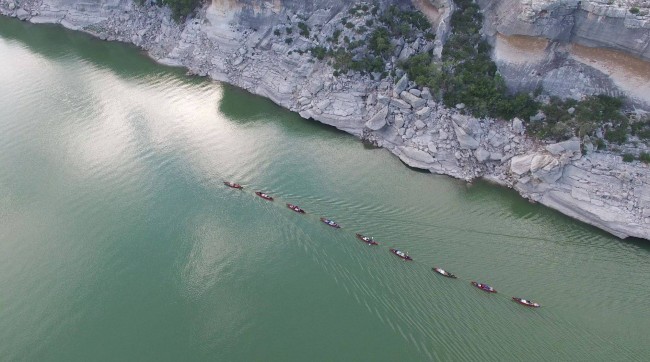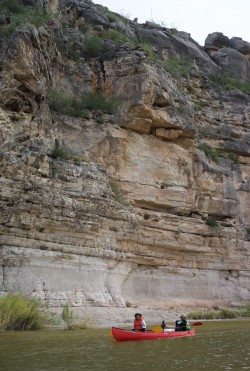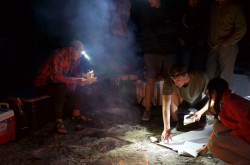Paddling the Pecos
October 13, 2016

By Charles Kerans, chair of the Department of Geological Sciences, Jackson School of Geosciences
The Carbonate and Evaporite Petrology class (GEO383M) typically visits localities like the Guadalupe Mountains and Paradox Basin—also called Death Valley—for its fall excursion. But in 2015, as in 2010, the class made the epic journey down the lower canyons of the Pecos more or less the only way it can be done: in canoes.

Charles Kerans.
This trip included 14 graduate students, including three carbonate graduate students with previous experience on the river. Chris Zahm, a research associate from the Bureau of Economic Geology with extensive experience in the structural evolution of the area, was another trip participant. Professor Charles Kerans, the instructor and trip leader, began running trips with two other Texas alumni, Laura Zahm and Bill Fitchen, in 1995. Much has changed since 1995 in terms of our understanding of the region, but its wild river setting is still the most compelling and unforgettable component.
The main geologic message of the trip is the detailed view of a carbonate ramp to intrashelf basin profile at true scale, as witnessed day-in and day-out for six days. The distinct signature of eustatic and biotic drivers that produce the spectacular suite of rudist and associated skeletal reefs and carbonate sand complexes is certainly among the best examples in the world of such a system, and is known to be a major petroleum system throughout the Lower Cretaceous of Texas and the Aptian and Cenomanian of the Middle East. Short stops along the river are mixed with half-day projects at key localities to ensure that participants gain lasting geologic knowledge to go along with their bruises, blisters and visions of spectacular scenery.

The trip doubles as a crash-course in canoeing as well as Cretaceous geology, and after a 25-mile first day of paddling, most of the navigational issues were resolved (most). Days 2-5 involved a mixture of paddling and stops at some of the more
spectacular side canyons. Along the way, brief stops to examine world-renowned rockart sites mix with the scenery and geology to shape a truly unforgettable experience.
A real reckoning of a sort wraps the trip with a 10-mile paddle and tow out of the slack-water stretch of Lake Amistad finishing at the Pecos. But this type of effort is expected of Jackson School graduate students both during studies and in their lifestyles, so the Pecos experience becomes just another unforgettable piece of the educational experience.
Back to the Newsletter